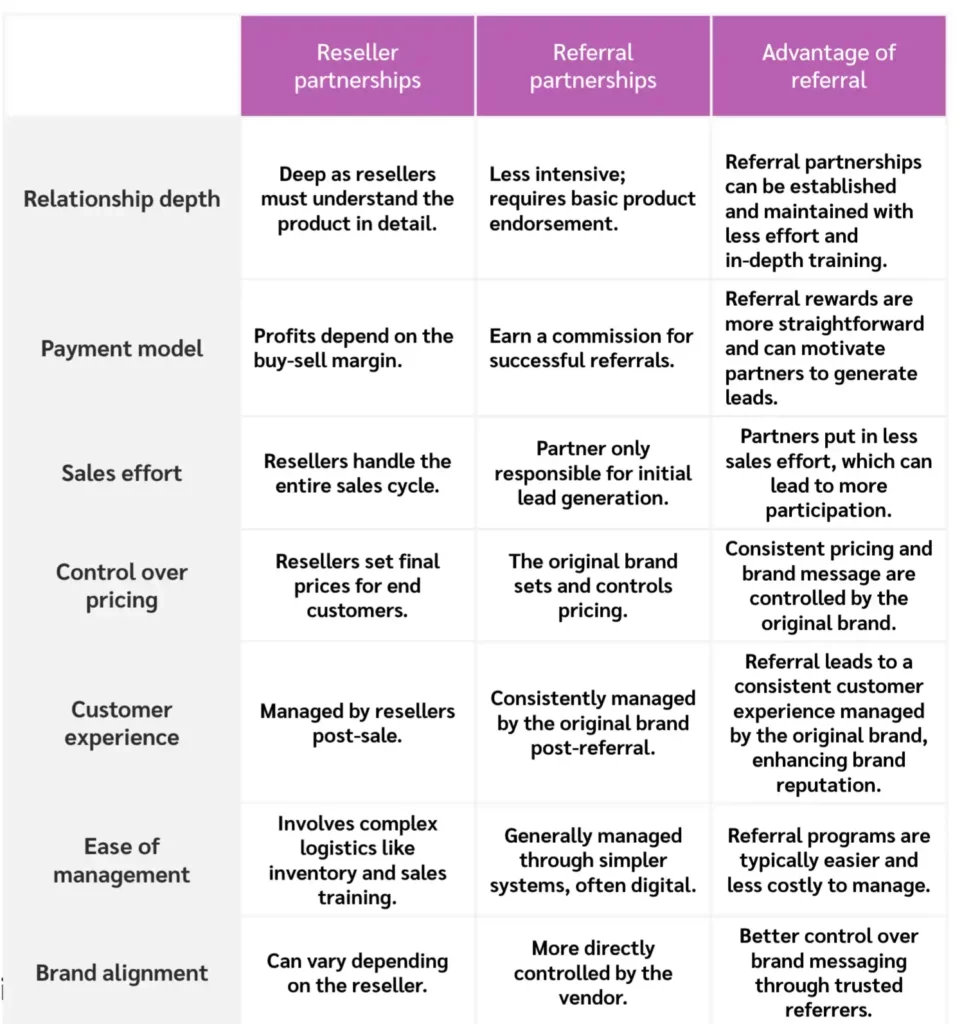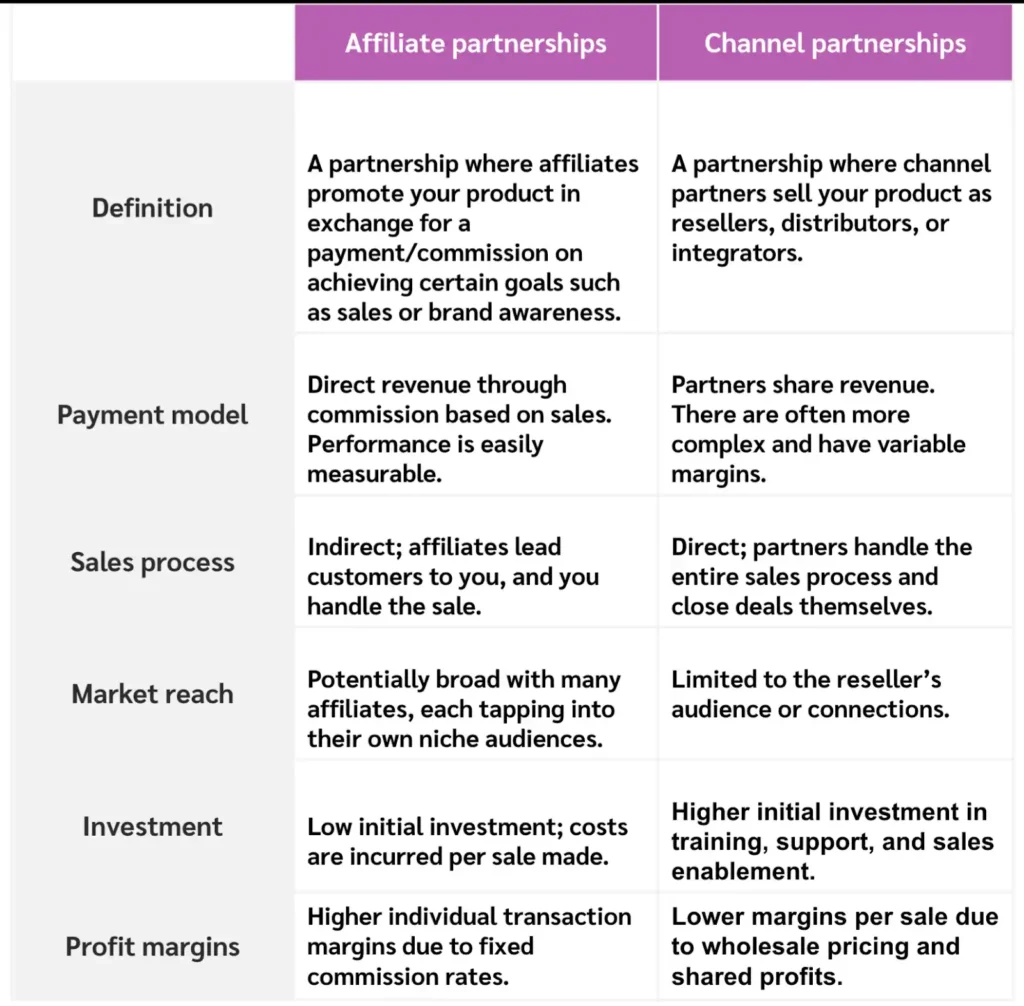Around 50 percent of consumers trust recommendations more than online banner ads, mobile ads, SMS messages, and SEO ads. Today, these recommendations come from referrals, affiliates, and influencers. Partnership marketing is a powerful way to reach your target audience and build trust at the same time.
Unlike channel partnerships, affiliate-type programs let you maintain control of your brand while driving performance directly tied to results. When your channel teams may have to juggle relationships, affiliate partnerships sit with your growth and demand gen teams.
Explore the various B2B partnerships available and pick the ones that best suit your business.
Affiliate-based partnership marketing can make up a big percentage of your revenue
Affiliate-type partnerships, or partnership marketing are a collaboration between two parties—typically two businesses or a business and an individual. This relationship introduces a brand to a partner’s customers or audiences. Both parties benefit by reaching shared business goals.
The winning formula with affiliate-based partnership marketing
- Bigger revenue streams. The average business generates high revenue from partnerships, so companies are investing even more. For example, affiliate marketing spending in the US reached $9.1B in 2021—an increase of 47 percent from 2018.
- Increased brand awareness. Collaborations with highly influential publishers and brands allow companies to reach untapped audiences.
- Greater customer retention. Partnerships enable brands to reach customers more frequently, stay top of mind, and encourage repeat purchases.
- Higher market share. Unique partnerships give companies first-mover advantages that capture market share faster than competitors..
- Increased conversion rates. Partnerships often drive highly relevant, high-intent visitors likelier to convert than on other channels.
- Low customer acquisition cost (CAC). The upfront investment for partnerships is lower than paid ads, since they use existing customer connections. For instance, M1 Finance achieved a 50 percent lower cost per quality user with partnerships versus paid search.

4 types of affiliate-based partnerships to increase brand awareness, grow your audience, and champion your brand
Use partnerships to expand your business’s reach and let respected voices highlight your product’s strengths. They create a chain reaction where one positive mention sparks another, each directly contributing to your brand’s growth.
1. Affiliate marketing puts your brand in front of more of your target audience
B2B affiliate marketing is a performance-based marketing channel. Affiliates promote products and services on behalf of brands. When these promotions lead to sales, the affiliate earns a commission.

Think of affiliate partnerships as a network of connectors. They amplify your product’s visibility in exchange for a performance-based commission. This setup is low-risk since compensation is tied directly to successful transactions.
Affiliates showcase your product on their channels, including a well-read blog, an influential social media account, or an industry-specific newsletter.
They receive payment when their recommendations achieve certain goals, like boosting sales or increasing brand awareness. Although most affiliate programs reward on last-click, brands can set commissions based on on alternative goals, like:
- Lead submission
- Free trial signup
- New subscriber
- Lead status
- First click to site
- Conversion path participation
- Monthly performance thresholds
- Customer status
- Promo code
Businesses often strategically partner with independent marketers whose tone matches their brand and target audience. Affiliate marketing expands market reach and drives sales through partners with solid rapport with your target audience.
For example, with the help of impact.com, customer relationship management (CRM) platform HubSpot gained a 50 percent increase in affiliate revenue and sign-ups. Affiliates can earn anywhere from 30 percent commission on every signup that converts to a paid subscription.

2. Referral marketing helps build trust among new customers
Referral marketing, or word-of-mouth marketing, can lead to higher trust and conversion rates. Authenticity and true product love will win over any ad––88 percent of consumers worldwide trust personal recommendations more than any other channel.
Referral marketing occurs when a customer introduces a company’s products or services to people they know.
If that intro leads to a new client or a sale, the person who made the referral (referrer) gets a thank you as a reward, discount, or commission. In some cases, the new customer also receives a reward when purchasing.
Referral partnerships rely on the trust and relationship established with the existing customer base to recommend services they may need or enjoy. It’s a professional give-and-take that can help grow your business through trusted networks.
To track referral conversions, businesses use tactics like referral links or coupon codes. These links and coupons are unique, trackable connections to customers, turning their promotions into measurable results. Each conversion via this link credits the customer and streamlines the payout process on your platform.

Customer advocates: Your current customers are often your most loyal advocates. They’re not just users—they’re your brand’s champions. With firsthand experience and faith in your product, they’re your authentic voice to the world. Their endorsement is gold in guiding a buyer. Spot them by tracking who brings new business your way. Other businesses can also act as referrers, especially in the case of B2B companies, where other businesses are customers.
Recommendations from customers can yield incredible results. For example, Flytographer launched a referral program where the referring customer receives a $25 credit towards their next shoot, and the newly acquired customer gets $25 off their first shoot. The referral program has driven over 2,500 customers and 1.2 million word-of-mouth sales.

3. Influencer marketing lends credibility to your brand
Influencer marketing is when businesses connect with influential people in their industry—those with a solid following and credibility. Influencers drive brand awareness and purchasing decisions through product placement and endorsements on social media. A reported 69 percent of consumers trust influencers, friends, and family over information from a brand.
Influencers share their positive experiences or insights about the product with their audience, helping businesses reach more potential customers in a relatable and authentic way. It’s a partnership that puts products in the spotlight through trusted voices within the community.
This type of engagement often feels more genuine than traditional advertising because followers view influencers as trusted sources of information. As a result, when an influencer shares a product or a brand story, their audience is more likely to pay attention, interact with the content, and even share it with their audience.
For example, the director of Pretty Little Marketer and B2B LinkedIn influencer promoted Hootsuite’s 2023 Social Media Career Report to her audience of social media marketers and freelancers. The result? Sophie’s post achieved over 5,000 likes and nearly 300 reposts.

4. Technology partnerships provide a better user experience
Technology partnerships are when brands promote their tech tools, platforms, or services together to their target audience. Tech brands work together to deliver better integrations, apps, or systems.
Technology partnerships shine when companies weave their products, often called ‘integration partnerships.’ By merging and enhancing data, they elevate the user experience and deliver more value to customers.
Plus, as an additional bonus, cross-promotion and a shared user base can drive sales for both parties. When brands cross-promote, they tap into each other’s user bases, building a larger combined audience to market to. This shared exposure is beneficial as it allows each brand to show its offerings to potential customers who have not engaged with the brand yet.
A classic example of a B2B technology partnership is the collaboration between Microsoft and Adobe.
The two tech giants partnered to make their apps work better together. Microsoft’s cloud platforms, like Azure and Dynamics 365, combined with Adobe’s marketing software suite, including Adobe Experience Cloud.

This partnership aimed to improve the offerings of both companies:
- Microsoft benefited from Adobe’s advanced content creation and marketing automation tools
- Adobe tapped into Microsoft’s robust cloud infrastructure and business intelligence solutions
The result? Businesses using services from both Microsoft and Adobe could seamlessly integrate their workflows. For example, customers used Adobe’s marketing tools to create personalized campaigns and then ran them on Microsoft platforms to analyze campaign performance with powerful AI and data analytics.
The partnership helped both businesses deliver a more cohesive and personalized customer experience driven by the combined power of Microsoft and Adobe’s technology.
Channel partnerships allow partners to manage sales
Channel partners act as an extension of your sales team, taking on the role of resellers, distributors, or value-added providers. They don’t just talk about your product—they actively sell it and integrate it into their broader solutions.
This type of partnership requires a substantial investment in both relationship-building and support. Brands must work with partners to create sales and marketing strategies, and provide training.
Reseller partners may take over brand ownership
A reseller acts as a broker between the brand and the customer, selling directly to the end user. Resellers have more control over how the partner sells the product. These merchants can include the product in bundles, sales, or other offers. Resellers usually get paid a percentage of the deals they close.
Unlike affiliates who kickstart the customer journey, resellers nurture and own the entire interaction with the customer. Navigating reseller partnerships can be complex, involving negotiations around pricing, sales territories, and product customization.
Brands often need to give resellers extra support and resources to ensure they have the knowledge and tools to successfully market and sell the products. Plus, resellers require brands to give up control over their reputation and standards. Since they act as a middleman with customers, it’s more difficult for brands to build user relationships.
The payoff is brands get access to a niche yet highly engaged audience. The key differences between reseller and referral partnerships:

The subtle nuances between affiliate-based and channel-based partnerships
Affiliate-based and channel partnerships may seem similar at first glance, but they have different strategies, benefits, and outcomes for your business.
Channel partnerships are costly and take a lot of effort and time to set up and manage. For these reasons, many brands turn to affiliate-based partnerships as a low-cost way to gain new revenue.
Check out the differences between affiliate and channel partnerships:

Affiliate-based partnerships are driving the future of B2B revenue growth
Get ready for the future with affiliate-based partnership models. They offer the agility, efficiency, and scalability that traditional channel partnerships often struggle to match. Affiliate-type partnerships are built around a performance-based model. This lets you track every marketing dollar you spend, which can lead to higher ROI and lower risk.
Using impact.com, businesses of all sizes can launch successful partnership programs. Whether running an affiliate, referral, influencer, tech partnership, or a mix of these, the platform equips you with all the tools and insights you need for your program to succeed. You have access to a vast network of potential partners. Plus, you’ll find it easy to manage everything from recruiting partners to paying them.
Ready to get more ROI on your partnership programs? Request a demo today.
B2B partnerships FAQs
Partnership marketing is when businesses or individuals help each other with their marketing. They use each other’s strengths to get more attention and customers than they could on their own.
This can involve everything, from simple promotional efforts to complex integrations of products or services. The main aim is to create a win-win scenario where each partner can leverage the other’s assets to expand their reach, enhance their offerings, or enter new markets.
1. Affiliate marketing
A SaaS company partners with a network of tech bloggers. Each blogger includes custom affiliate links in their articles or email newsletters. The blogger earns a commission when a reader clicks through and signs up for the service. This model incentivizes the bloggers to produce compelling content about the SaaS product and enables the company to reach a broader, tech-savvy audience.
2. Referral partnerships
A B2B sales enablement platform offers existing clients a discount on their monthly subscription fee for every new client they refer. This creates a win-win scenario where existing clients become advocates for the brand. Customers are driven by the tangible benefit of a service discount, and the company acquires new customers at a lower acquisition cost.
3. Influencer marketing
A cybersecurity company that provides solutions for businesses partners with respected thought leaders in the IT security field. These influencers are active on professional networks like LinkedIn and speak at industry conferences.
These thought leaders influence decision-makers at other companies by sharing their positive experiences and providing insights on how they enhance business operations. Their recommendations may nudge other businesses looking to adopt this kind of solution for their IT security needs.
To start a partnership marketing program, define your goals and what you want to achieve. Next, identify potential partners who share a similar audience and values.
Reach out to partners with a clear proposal that outlines the mutual benefits. Once a partner agrees, work together to set terms, decide on the specifics of your campaign, and establish how you’ll measure success. Then, launch your partnership marketing efforts and keep communication open to ensure both parties benefit and achieve their goals.
Starting a partnership program has many steps, but a partnership management platform like impact.com streamlines and automates every stage of the process.




